Brand Management Report: Strategies and Analysis for Dyson Ltd
VerifiedAdded on 2023/01/09
|17
|5565
|90
Report
AI Summary
This report provides a comprehensive analysis of brand management strategies, using Dyson Ltd as a case study. It begins with an introduction to brand management and its significance as a marketing tool, emphasizing its role in building brand recognition, increasing business value, attracting customers, and fostering trust. The report then delves into successful brand strategy components, including target audience, brand perception, brand awareness, and brand positioning. It explores how brands are managed successfully using models like Keller's brand equity model and provides validated examples using Dyson's innovative product offerings. Furthermore, the report examines brand hierarchy, portfolio management, and brand equity management strategies, including active and passive portfolio management. It also discusses collaborative brand management and partnerships, exploring techniques to leverage and extend brands. Finally, the report evaluates methods for managing and measuring brand value, concluding with a comprehensive understanding of branding and its impact on business performance and market presence. The report provides a detailed overview of Dyson's marketing strategies and brand management practices.
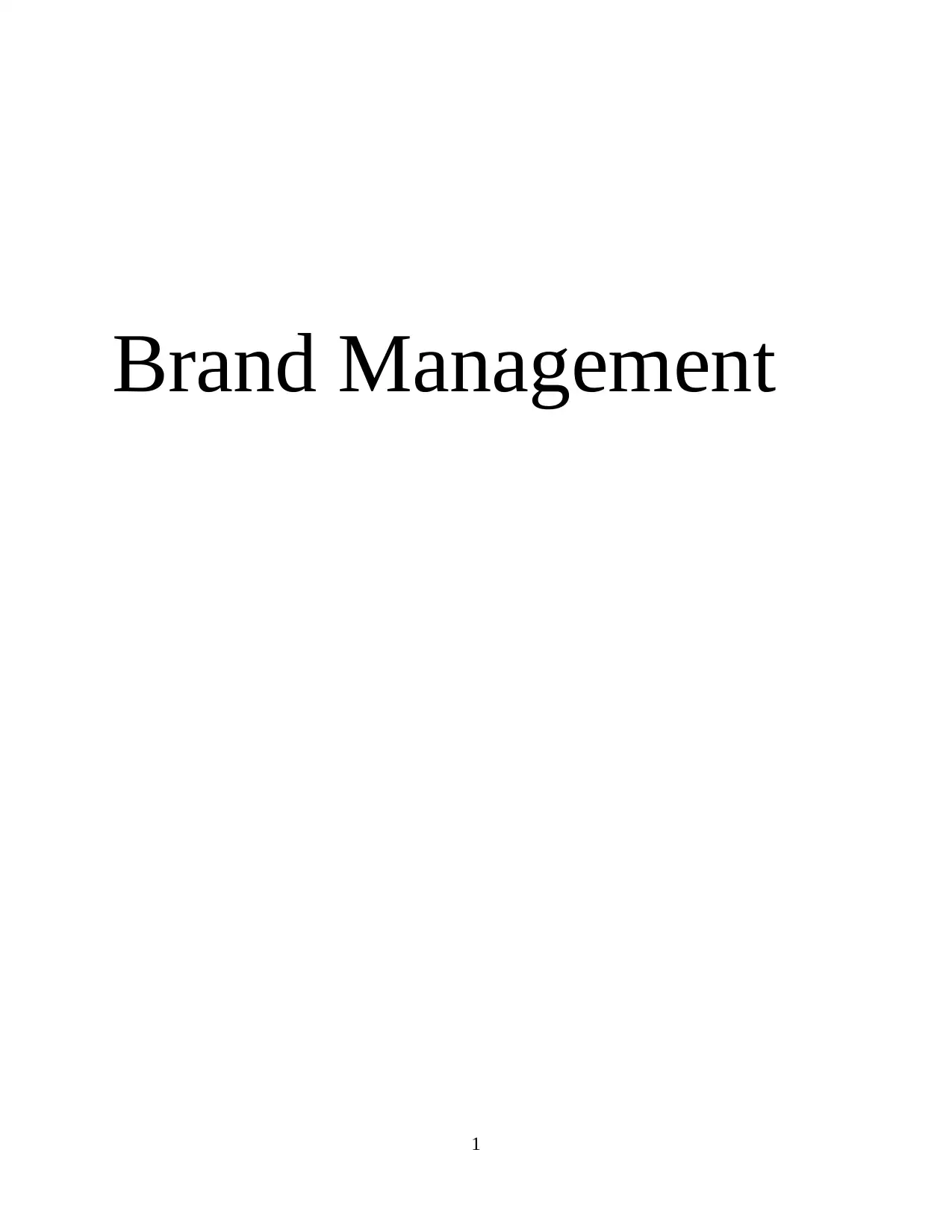
Brand Management
1
1
Paraphrase This Document
Need a fresh take? Get an instant paraphrase of this document with our AI Paraphraser
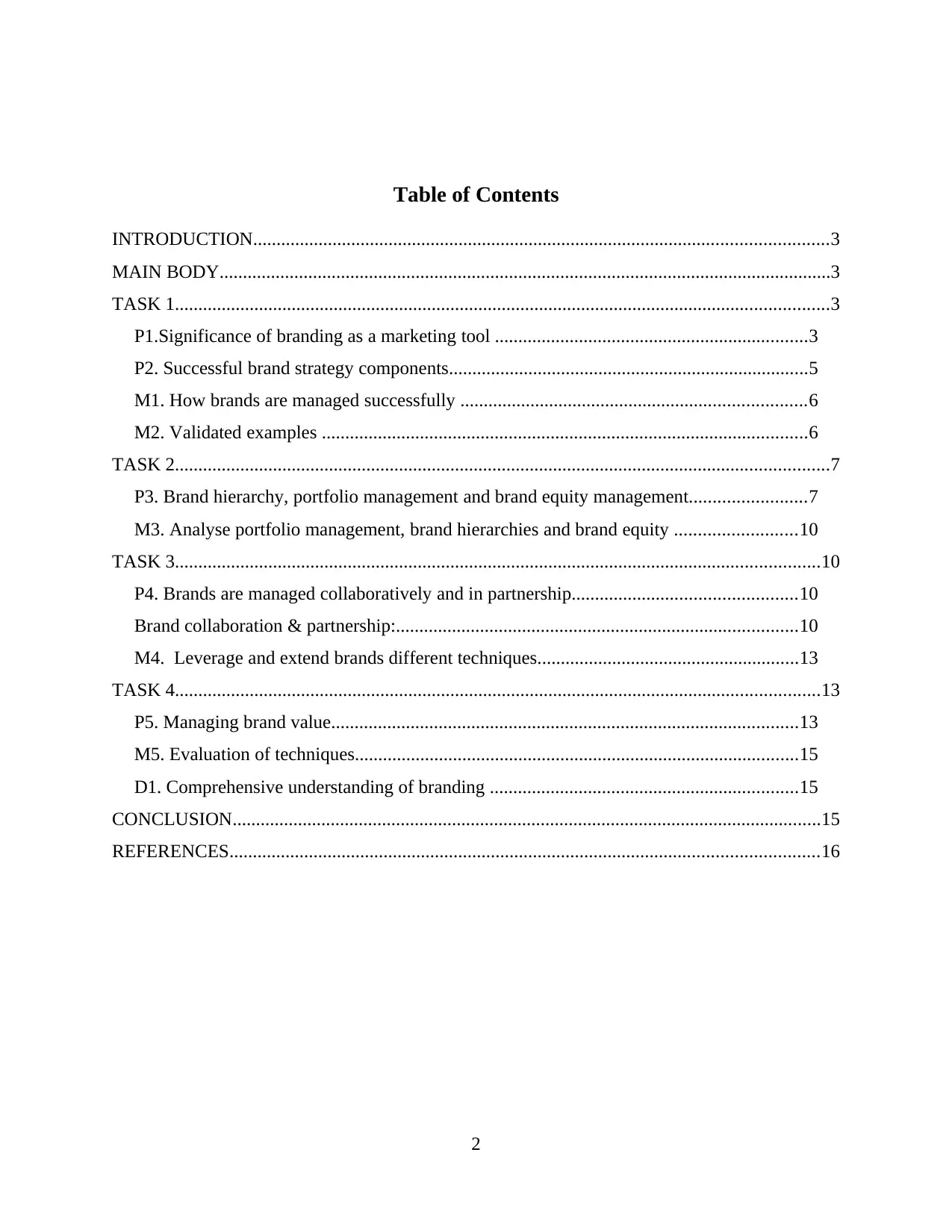
Table of Contents
INTRODUCTION...........................................................................................................................3
MAIN BODY...................................................................................................................................3
TASK 1............................................................................................................................................3
P1.Significance of branding as a marketing tool ...................................................................3
P2. Successful brand strategy components.............................................................................5
M1. How brands are managed successfully ..........................................................................6
M2. Validated examples ........................................................................................................6
TASK 2............................................................................................................................................7
P3. Brand hierarchy, portfolio management and brand equity management.........................7
M3. Analyse portfolio management, brand hierarchies and brand equity ..........................10
TASK 3..........................................................................................................................................10
P4. Brands are managed collaboratively and in partnership................................................10
Brand collaboration & partnership:......................................................................................10
M4. Leverage and extend brands different techniques........................................................13
TASK 4..........................................................................................................................................13
P5. Managing brand value....................................................................................................13
M5. Evaluation of techniques...............................................................................................15
D1. Comprehensive understanding of branding ..................................................................15
CONCLUSION..............................................................................................................................15
REFERENCES..............................................................................................................................16
2
INTRODUCTION...........................................................................................................................3
MAIN BODY...................................................................................................................................3
TASK 1............................................................................................................................................3
P1.Significance of branding as a marketing tool ...................................................................3
P2. Successful brand strategy components.............................................................................5
M1. How brands are managed successfully ..........................................................................6
M2. Validated examples ........................................................................................................6
TASK 2............................................................................................................................................7
P3. Brand hierarchy, portfolio management and brand equity management.........................7
M3. Analyse portfolio management, brand hierarchies and brand equity ..........................10
TASK 3..........................................................................................................................................10
P4. Brands are managed collaboratively and in partnership................................................10
Brand collaboration & partnership:......................................................................................10
M4. Leverage and extend brands different techniques........................................................13
TASK 4..........................................................................................................................................13
P5. Managing brand value....................................................................................................13
M5. Evaluation of techniques...............................................................................................15
D1. Comprehensive understanding of branding ..................................................................15
CONCLUSION..............................................................................................................................15
REFERENCES..............................................................................................................................16
2
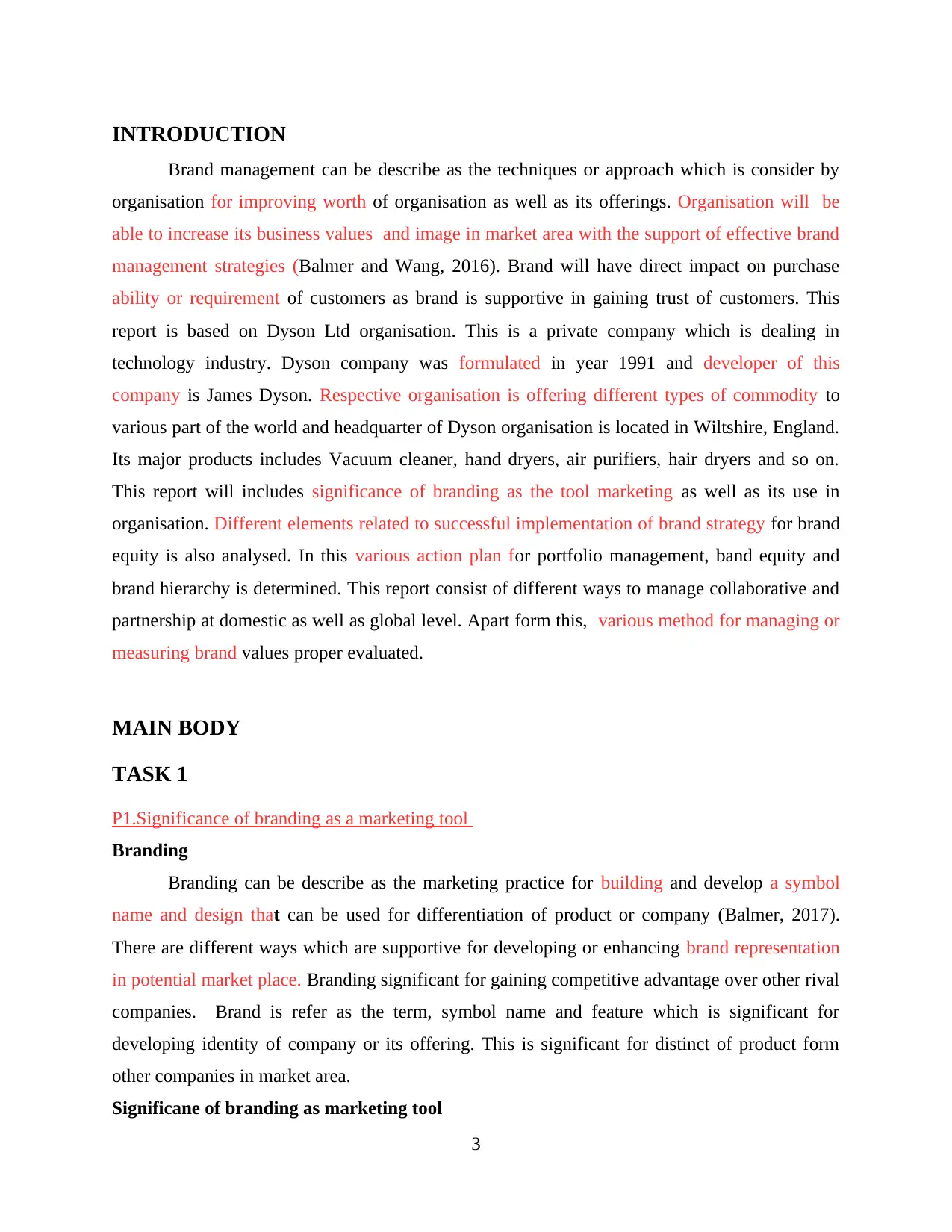
INTRODUCTION
Brand management can be describe as the techniques or approach which is consider by
organisation for improving worth of organisation as well as its offerings. Organisation will be
able to increase its business values and image in market area with the support of effective brand
management strategies (Balmer and Wang, 2016). Brand will have direct impact on purchase
ability or requirement of customers as brand is supportive in gaining trust of customers. This
report is based on Dyson Ltd organisation. This is a private company which is dealing in
technology industry. Dyson company was formulated in year 1991 and developer of this
company is James Dyson. Respective organisation is offering different types of commodity to
various part of the world and headquarter of Dyson organisation is located in Wiltshire, England.
Its major products includes Vacuum cleaner, hand dryers, air purifiers, hair dryers and so on.
This report will includes significance of branding as the tool marketing as well as its use in
organisation. Different elements related to successful implementation of brand strategy for brand
equity is also analysed. In this various action plan for portfolio management, band equity and
brand hierarchy is determined. This report consist of different ways to manage collaborative and
partnership at domestic as well as global level. Apart form this, various method for managing or
measuring brand values proper evaluated.
MAIN BODY
TASK 1
P1.Significance of branding as a marketing tool
Branding
Branding can be describe as the marketing practice for building and develop a symbol
name and design that can be used for differentiation of product or company (Balmer, 2017).
There are different ways which are supportive for developing or enhancing brand representation
in potential market place. Branding significant for gaining competitive advantage over other rival
companies. Brand is refer as the term, symbol name and feature which is significant for
developing identity of company or its offering. This is significant for distinct of product form
other companies in market area.
Significane of branding as marketing tool
3
Brand management can be describe as the techniques or approach which is consider by
organisation for improving worth of organisation as well as its offerings. Organisation will be
able to increase its business values and image in market area with the support of effective brand
management strategies (Balmer and Wang, 2016). Brand will have direct impact on purchase
ability or requirement of customers as brand is supportive in gaining trust of customers. This
report is based on Dyson Ltd organisation. This is a private company which is dealing in
technology industry. Dyson company was formulated in year 1991 and developer of this
company is James Dyson. Respective organisation is offering different types of commodity to
various part of the world and headquarter of Dyson organisation is located in Wiltshire, England.
Its major products includes Vacuum cleaner, hand dryers, air purifiers, hair dryers and so on.
This report will includes significance of branding as the tool marketing as well as its use in
organisation. Different elements related to successful implementation of brand strategy for brand
equity is also analysed. In this various action plan for portfolio management, band equity and
brand hierarchy is determined. This report consist of different ways to manage collaborative and
partnership at domestic as well as global level. Apart form this, various method for managing or
measuring brand values proper evaluated.
MAIN BODY
TASK 1
P1.Significance of branding as a marketing tool
Branding
Branding can be describe as the marketing practice for building and develop a symbol
name and design that can be used for differentiation of product or company (Balmer, 2017).
There are different ways which are supportive for developing or enhancing brand representation
in potential market place. Branding significant for gaining competitive advantage over other rival
companies. Brand is refer as the term, symbol name and feature which is significant for
developing identity of company or its offering. This is significant for distinct of product form
other companies in market area.
Significane of branding as marketing tool
3
⊘ This is a preview!⊘
Do you want full access?
Subscribe today to unlock all pages.

Trusted by 1+ million students worldwide
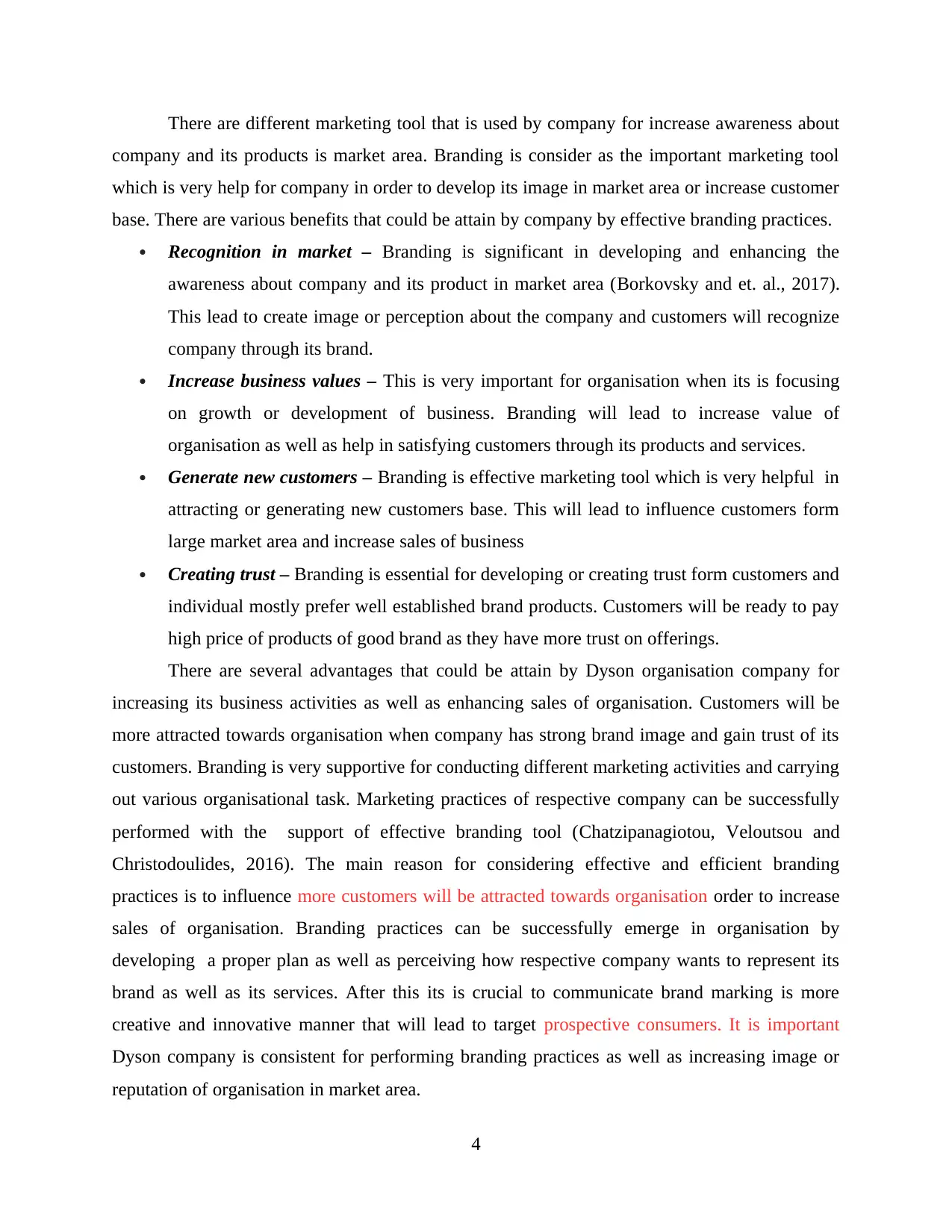
There are different marketing tool that is used by company for increase awareness about
company and its products is market area. Branding is consider as the important marketing tool
which is very help for company in order to develop its image in market area or increase customer
base. There are various benefits that could be attain by company by effective branding practices.
Recognition in market – Branding is significant in developing and enhancing the
awareness about company and its product in market area (Borkovsky and et. al., 2017).
This lead to create image or perception about the company and customers will recognize
company through its brand.
Increase business values – This is very important for organisation when its is focusing
on growth or development of business. Branding will lead to increase value of
organisation as well as help in satisfying customers through its products and services.
Generate new customers – Branding is effective marketing tool which is very helpful in
attracting or generating new customers base. This will lead to influence customers form
large market area and increase sales of business
Creating trust – Branding is essential for developing or creating trust form customers and
individual mostly prefer well established brand products. Customers will be ready to pay
high price of products of good brand as they have more trust on offerings.
There are several advantages that could be attain by Dyson organisation company for
increasing its business activities as well as enhancing sales of organisation. Customers will be
more attracted towards organisation when company has strong brand image and gain trust of its
customers. Branding is very supportive for conducting different marketing activities and carrying
out various organisational task. Marketing practices of respective company can be successfully
performed with the support of effective branding tool (Chatzipanagiotou, Veloutsou and
Christodoulides, 2016). The main reason for considering effective and efficient branding
practices is to influence more customers will be attracted towards organisation order to increase
sales of organisation. Branding practices can be successfully emerge in organisation by
developing a proper plan as well as perceiving how respective company wants to represent its
brand as well as its services. After this its is crucial to communicate brand marking is more
creative and innovative manner that will lead to target prospective consumers. It is important
Dyson company is consistent for performing branding practices as well as increasing image or
reputation of organisation in market area.
4
company and its products is market area. Branding is consider as the important marketing tool
which is very help for company in order to develop its image in market area or increase customer
base. There are various benefits that could be attain by company by effective branding practices.
Recognition in market – Branding is significant in developing and enhancing the
awareness about company and its product in market area (Borkovsky and et. al., 2017).
This lead to create image or perception about the company and customers will recognize
company through its brand.
Increase business values – This is very important for organisation when its is focusing
on growth or development of business. Branding will lead to increase value of
organisation as well as help in satisfying customers through its products and services.
Generate new customers – Branding is effective marketing tool which is very helpful in
attracting or generating new customers base. This will lead to influence customers form
large market area and increase sales of business
Creating trust – Branding is essential for developing or creating trust form customers and
individual mostly prefer well established brand products. Customers will be ready to pay
high price of products of good brand as they have more trust on offerings.
There are several advantages that could be attain by Dyson organisation company for
increasing its business activities as well as enhancing sales of organisation. Customers will be
more attracted towards organisation when company has strong brand image and gain trust of its
customers. Branding is very supportive for conducting different marketing activities and carrying
out various organisational task. Marketing practices of respective company can be successfully
performed with the support of effective branding tool (Chatzipanagiotou, Veloutsou and
Christodoulides, 2016). The main reason for considering effective and efficient branding
practices is to influence more customers will be attracted towards organisation order to increase
sales of organisation. Branding practices can be successfully emerge in organisation by
developing a proper plan as well as perceiving how respective company wants to represent its
brand as well as its services. After this its is crucial to communicate brand marking is more
creative and innovative manner that will lead to target prospective consumers. It is important
Dyson company is consistent for performing branding practices as well as increasing image or
reputation of organisation in market area.
4
Paraphrase This Document
Need a fresh take? Get an instant paraphrase of this document with our AI Paraphraser
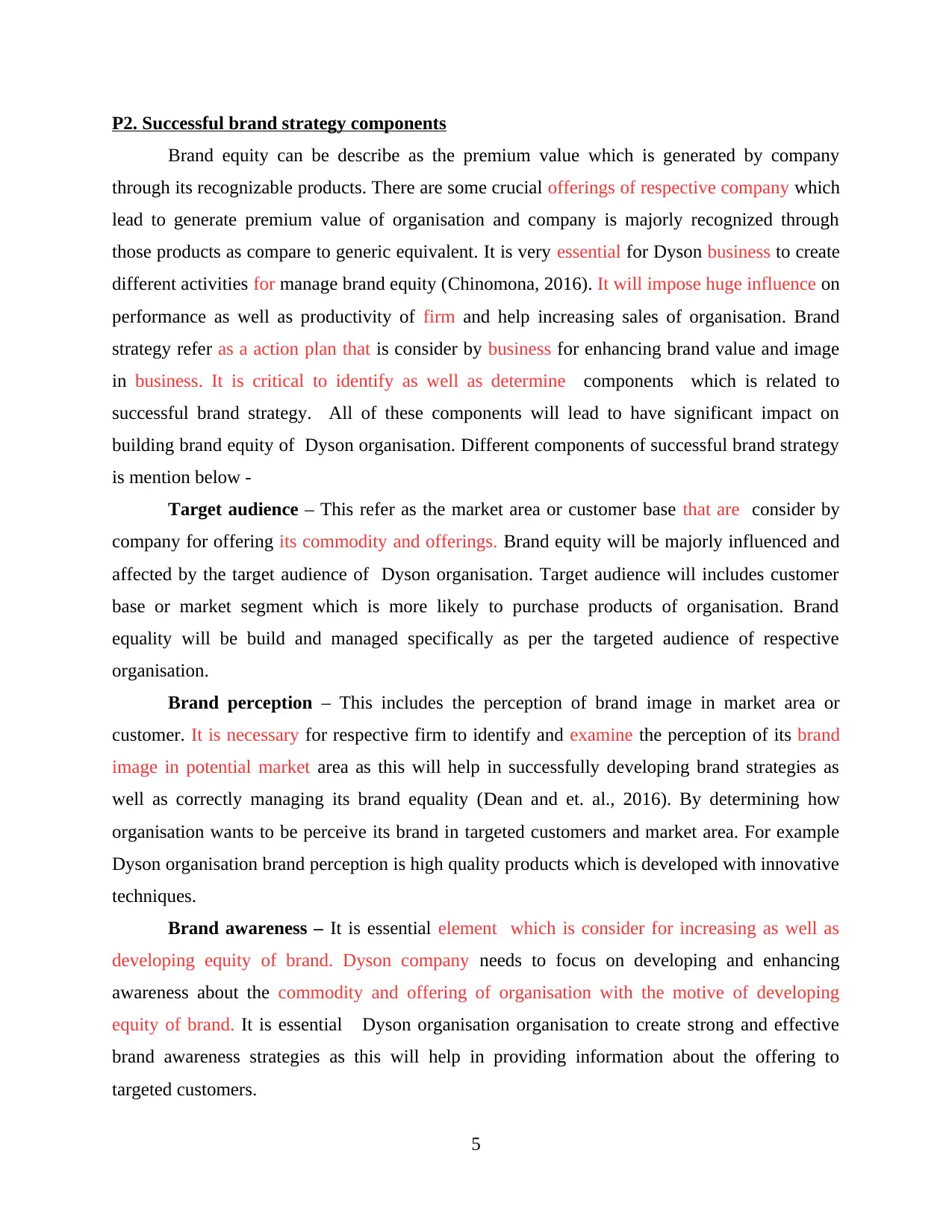
P2. Successful brand strategy components
Brand equity can be describe as the premium value which is generated by company
through its recognizable products. There are some crucial offerings of respective company which
lead to generate premium value of organisation and company is majorly recognized through
those products as compare to generic equivalent. It is very essential for Dyson business to create
different activities for manage brand equity (Chinomona, 2016). It will impose huge influence on
performance as well as productivity of firm and help increasing sales of organisation. Brand
strategy refer as a action plan that is consider by business for enhancing brand value and image
in business. It is critical to identify as well as determine components which is related to
successful brand strategy. All of these components will lead to have significant impact on
building brand equity of Dyson organisation. Different components of successful brand strategy
is mention below -
Target audience – This refer as the market area or customer base that are consider by
company for offering its commodity and offerings. Brand equity will be majorly influenced and
affected by the target audience of Dyson organisation. Target audience will includes customer
base or market segment which is more likely to purchase products of organisation. Brand
equality will be build and managed specifically as per the targeted audience of respective
organisation.
Brand perception – This includes the perception of brand image in market area or
customer. It is necessary for respective firm to identify and examine the perception of its brand
image in potential market area as this will help in successfully developing brand strategies as
well as correctly managing its brand equality (Dean and et. al., 2016). By determining how
organisation wants to be perceive its brand in targeted customers and market area. For example
Dyson organisation brand perception is high quality products which is developed with innovative
techniques.
Brand awareness – It is essential element which is consider for increasing as well as
developing equity of brand. Dyson company needs to focus on developing and enhancing
awareness about the commodity and offering of organisation with the motive of developing
equity of brand. It is essential Dyson organisation organisation to create strong and effective
brand awareness strategies as this will help in providing information about the offering to
targeted customers.
5
Brand equity can be describe as the premium value which is generated by company
through its recognizable products. There are some crucial offerings of respective company which
lead to generate premium value of organisation and company is majorly recognized through
those products as compare to generic equivalent. It is very essential for Dyson business to create
different activities for manage brand equity (Chinomona, 2016). It will impose huge influence on
performance as well as productivity of firm and help increasing sales of organisation. Brand
strategy refer as a action plan that is consider by business for enhancing brand value and image
in business. It is critical to identify as well as determine components which is related to
successful brand strategy. All of these components will lead to have significant impact on
building brand equity of Dyson organisation. Different components of successful brand strategy
is mention below -
Target audience – This refer as the market area or customer base that are consider by
company for offering its commodity and offerings. Brand equity will be majorly influenced and
affected by the target audience of Dyson organisation. Target audience will includes customer
base or market segment which is more likely to purchase products of organisation. Brand
equality will be build and managed specifically as per the targeted audience of respective
organisation.
Brand perception – This includes the perception of brand image in market area or
customer. It is necessary for respective firm to identify and examine the perception of its brand
image in potential market area as this will help in successfully developing brand strategies as
well as correctly managing its brand equality (Dean and et. al., 2016). By determining how
organisation wants to be perceive its brand in targeted customers and market area. For example
Dyson organisation brand perception is high quality products which is developed with innovative
techniques.
Brand awareness – It is essential element which is consider for increasing as well as
developing equity of brand. Dyson company needs to focus on developing and enhancing
awareness about the commodity and offering of organisation with the motive of developing
equity of brand. It is essential Dyson organisation organisation to create strong and effective
brand awareness strategies as this will help in providing information about the offering to
targeted customers.
5
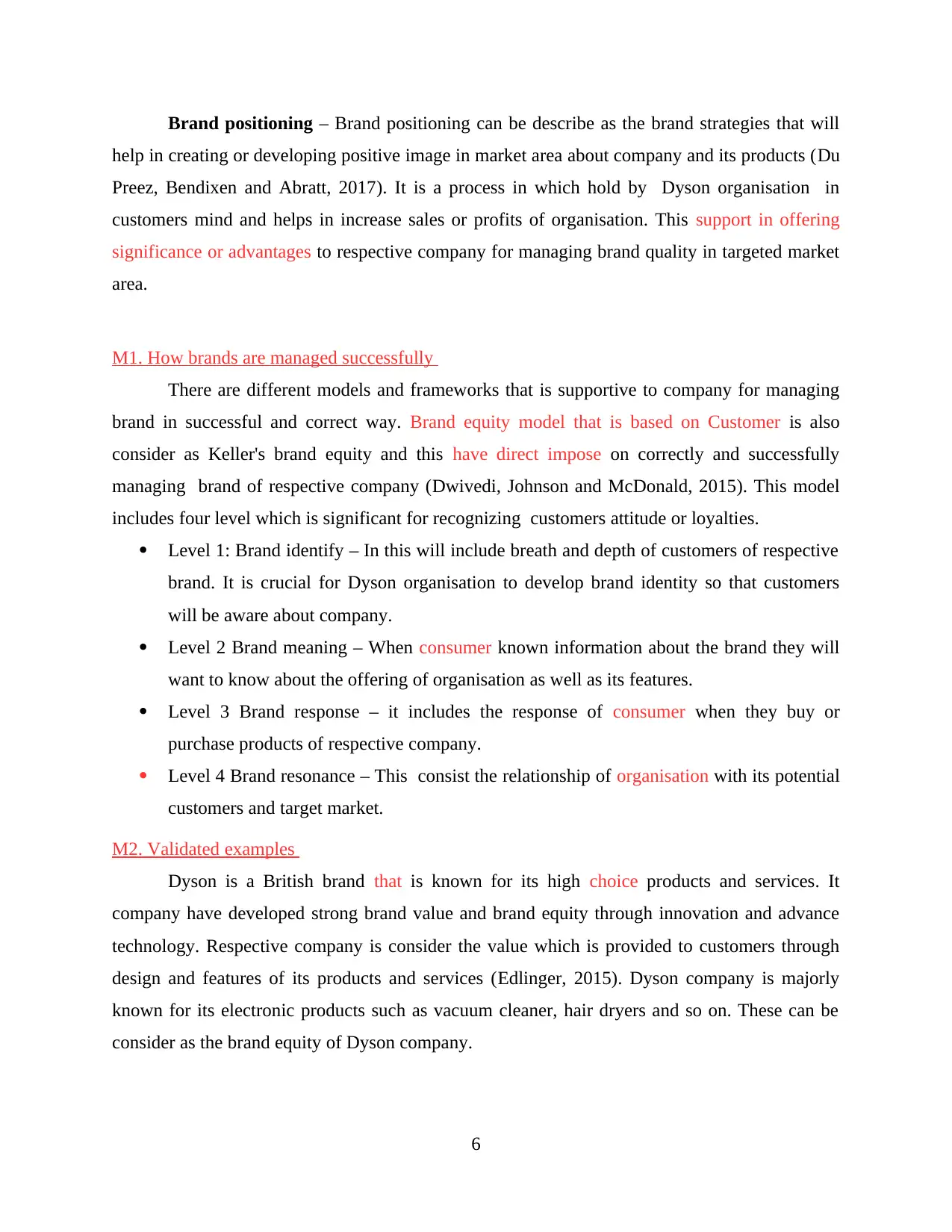
Brand positioning – Brand positioning can be describe as the brand strategies that will
help in creating or developing positive image in market area about company and its products (Du
Preez, Bendixen and Abratt, 2017). It is a process in which hold by Dyson organisation in
customers mind and helps in increase sales or profits of organisation. This support in offering
significance or advantages to respective company for managing brand quality in targeted market
area.
M1. How brands are managed successfully
There are different models and frameworks that is supportive to company for managing
brand in successful and correct way. Brand equity model that is based on Customer is also
consider as Keller's brand equity and this have direct impose on correctly and successfully
managing brand of respective company (Dwivedi, Johnson and McDonald, 2015). This model
includes four level which is significant for recognizing customers attitude or loyalties.
Level 1: Brand identify – In this will include breath and depth of customers of respective
brand. It is crucial for Dyson organisation to develop brand identity so that customers
will be aware about company.
Level 2 Brand meaning – When consumer known information about the brand they will
want to know about the offering of organisation as well as its features.
Level 3 Brand response – it includes the response of consumer when they buy or
purchase products of respective company.
Level 4 Brand resonance – This consist the relationship of organisation with its potential
customers and target market.
M2. Validated examples
Dyson is a British brand that is known for its high choice products and services. It
company have developed strong brand value and brand equity through innovation and advance
technology. Respective company is consider the value which is provided to customers through
design and features of its products and services (Edlinger, 2015). Dyson company is majorly
known for its electronic products such as vacuum cleaner, hair dryers and so on. These can be
consider as the brand equity of Dyson company.
6
help in creating or developing positive image in market area about company and its products (Du
Preez, Bendixen and Abratt, 2017). It is a process in which hold by Dyson organisation in
customers mind and helps in increase sales or profits of organisation. This support in offering
significance or advantages to respective company for managing brand quality in targeted market
area.
M1. How brands are managed successfully
There are different models and frameworks that is supportive to company for managing
brand in successful and correct way. Brand equity model that is based on Customer is also
consider as Keller's brand equity and this have direct impose on correctly and successfully
managing brand of respective company (Dwivedi, Johnson and McDonald, 2015). This model
includes four level which is significant for recognizing customers attitude or loyalties.
Level 1: Brand identify – In this will include breath and depth of customers of respective
brand. It is crucial for Dyson organisation to develop brand identity so that customers
will be aware about company.
Level 2 Brand meaning – When consumer known information about the brand they will
want to know about the offering of organisation as well as its features.
Level 3 Brand response – it includes the response of consumer when they buy or
purchase products of respective company.
Level 4 Brand resonance – This consist the relationship of organisation with its potential
customers and target market.
M2. Validated examples
Dyson is a British brand that is known for its high choice products and services. It
company have developed strong brand value and brand equity through innovation and advance
technology. Respective company is consider the value which is provided to customers through
design and features of its products and services (Edlinger, 2015). Dyson company is majorly
known for its electronic products such as vacuum cleaner, hair dryers and so on. These can be
consider as the brand equity of Dyson company.
6
⊘ This is a preview!⊘
Do you want full access?
Subscribe today to unlock all pages.

Trusted by 1+ million students worldwide
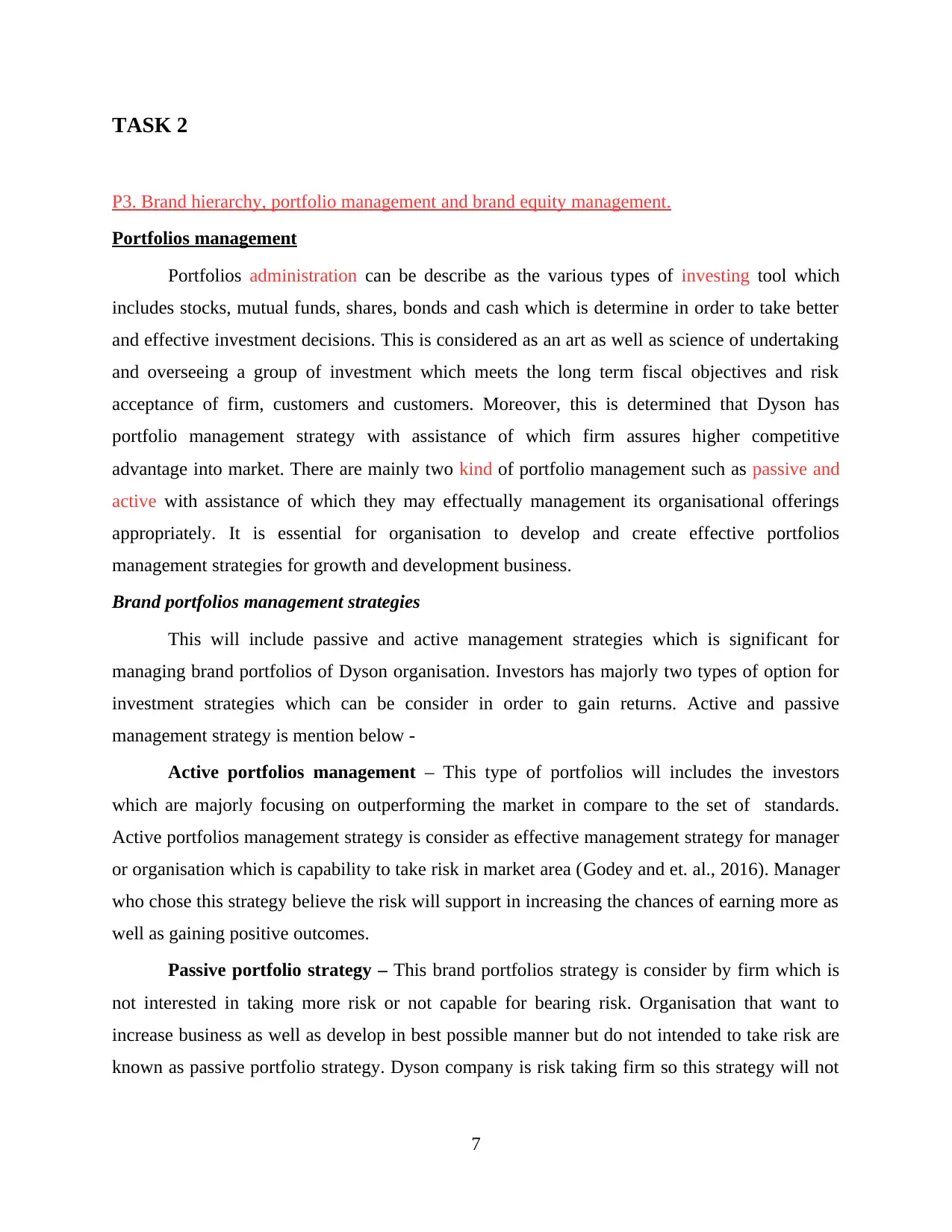
TASK 2
P3. Brand hierarchy, portfolio management and brand equity management.
Portfolios management
Portfolios administration can be describe as the various types of investing tool which
includes stocks, mutual funds, shares, bonds and cash which is determine in order to take better
and effective investment decisions. This is considered as an art as well as science of undertaking
and overseeing a group of investment which meets the long term fiscal objectives and risk
acceptance of firm, customers and customers. Moreover, this is determined that Dyson has
portfolio management strategy with assistance of which firm assures higher competitive
advantage into market. There are mainly two kind of portfolio management such as passive and
active with assistance of which they may effectually management its organisational offerings
appropriately. It is essential for organisation to develop and create effective portfolios
management strategies for growth and development business.
Brand portfolios management strategies
This will include passive and active management strategies which is significant for
managing brand portfolios of Dyson organisation. Investors has majorly two types of option for
investment strategies which can be consider in order to gain returns. Active and passive
management strategy is mention below -
Active portfolios management – This type of portfolios will includes the investors
which are majorly focusing on outperforming the market in compare to the set of standards.
Active portfolios management strategy is consider as effective management strategy for manager
or organisation which is capability to take risk in market area (Godey and et. al., 2016). Manager
who chose this strategy believe the risk will support in increasing the chances of earning more as
well as gaining positive outcomes.
Passive portfolio strategy – This brand portfolios strategy is consider by firm which is
not interested in taking more risk or not capable for bearing risk. Organisation that want to
increase business as well as develop in best possible manner but do not intended to take risk are
known as passive portfolio strategy. Dyson company is risk taking firm so this strategy will not
7
P3. Brand hierarchy, portfolio management and brand equity management.
Portfolios management
Portfolios administration can be describe as the various types of investing tool which
includes stocks, mutual funds, shares, bonds and cash which is determine in order to take better
and effective investment decisions. This is considered as an art as well as science of undertaking
and overseeing a group of investment which meets the long term fiscal objectives and risk
acceptance of firm, customers and customers. Moreover, this is determined that Dyson has
portfolio management strategy with assistance of which firm assures higher competitive
advantage into market. There are mainly two kind of portfolio management such as passive and
active with assistance of which they may effectually management its organisational offerings
appropriately. It is essential for organisation to develop and create effective portfolios
management strategies for growth and development business.
Brand portfolios management strategies
This will include passive and active management strategies which is significant for
managing brand portfolios of Dyson organisation. Investors has majorly two types of option for
investment strategies which can be consider in order to gain returns. Active and passive
management strategy is mention below -
Active portfolios management – This type of portfolios will includes the investors
which are majorly focusing on outperforming the market in compare to the set of standards.
Active portfolios management strategy is consider as effective management strategy for manager
or organisation which is capability to take risk in market area (Godey and et. al., 2016). Manager
who chose this strategy believe the risk will support in increasing the chances of earning more as
well as gaining positive outcomes.
Passive portfolio strategy – This brand portfolios strategy is consider by firm which is
not interested in taking more risk or not capable for bearing risk. Organisation that want to
increase business as well as develop in best possible manner but do not intended to take risk are
known as passive portfolio strategy. Dyson company is risk taking firm so this strategy will not
7
Paraphrase This Document
Need a fresh take? Get an instant paraphrase of this document with our AI Paraphraser
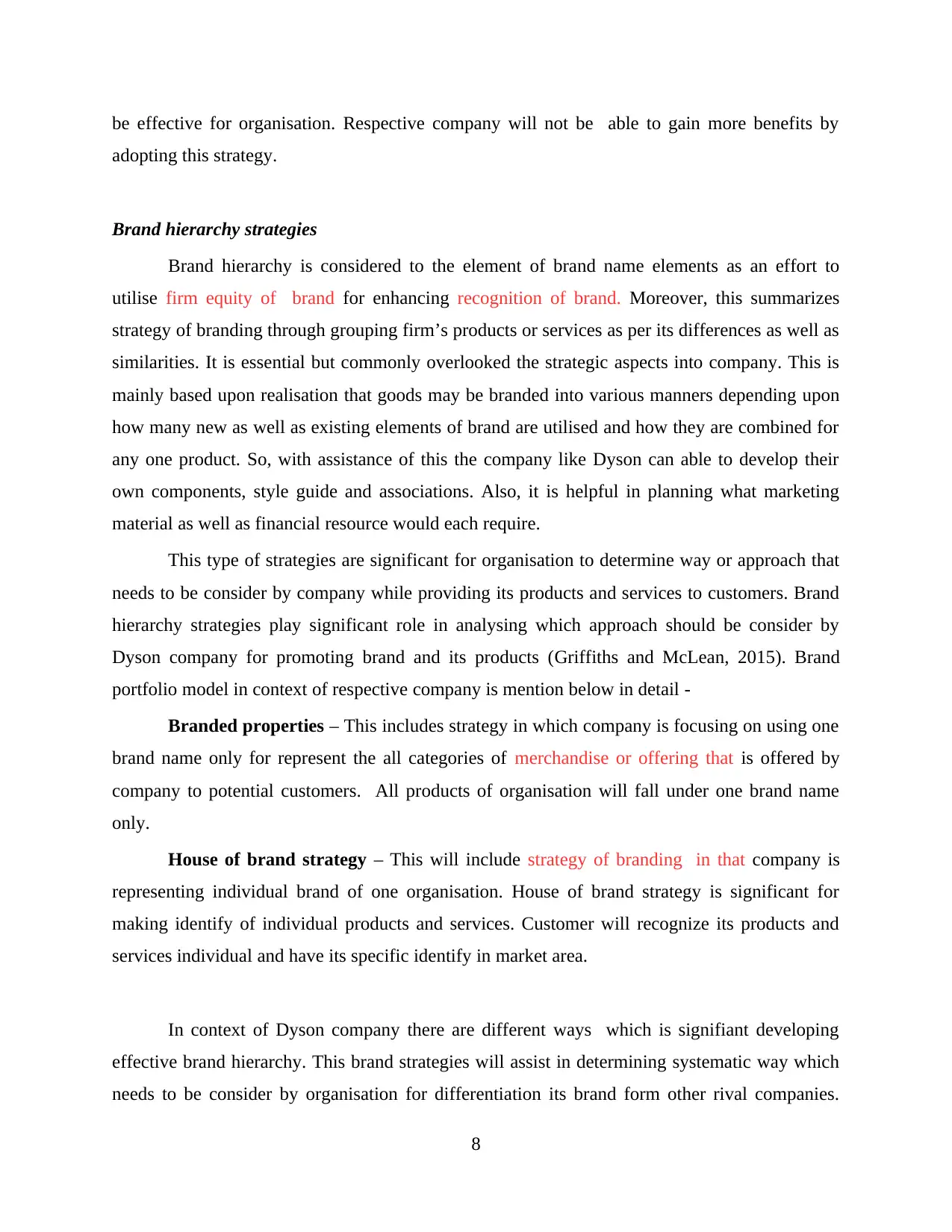
be effective for organisation. Respective company will not be able to gain more benefits by
adopting this strategy.
Brand hierarchy strategies
Brand hierarchy is considered to the element of brand name elements as an effort to
utilise firm equity of brand for enhancing recognition of brand. Moreover, this summarizes
strategy of branding through grouping firm’s products or services as per its differences as well as
similarities. It is essential but commonly overlooked the strategic aspects into company. This is
mainly based upon realisation that goods may be branded into various manners depending upon
how many new as well as existing elements of brand are utilised and how they are combined for
any one product. So, with assistance of this the company like Dyson can able to develop their
own components, style guide and associations. Also, it is helpful in planning what marketing
material as well as financial resource would each require.
This type of strategies are significant for organisation to determine way or approach that
needs to be consider by company while providing its products and services to customers. Brand
hierarchy strategies play significant role in analysing which approach should be consider by
Dyson company for promoting brand and its products (Griffiths and McLean, 2015). Brand
portfolio model in context of respective company is mention below in detail -
Branded properties – This includes strategy in which company is focusing on using one
brand name only for represent the all categories of merchandise or offering that is offered by
company to potential customers. All products of organisation will fall under one brand name
only.
House of brand strategy – This will include strategy of branding in that company is
representing individual brand of one organisation. House of brand strategy is significant for
making identify of individual products and services. Customer will recognize its products and
services individual and have its specific identify in market area.
In context of Dyson company there are different ways which is signifiant developing
effective brand hierarchy. This brand strategies will assist in determining systematic way which
needs to be consider by organisation for differentiation its brand form other rival companies.
8
adopting this strategy.
Brand hierarchy strategies
Brand hierarchy is considered to the element of brand name elements as an effort to
utilise firm equity of brand for enhancing recognition of brand. Moreover, this summarizes
strategy of branding through grouping firm’s products or services as per its differences as well as
similarities. It is essential but commonly overlooked the strategic aspects into company. This is
mainly based upon realisation that goods may be branded into various manners depending upon
how many new as well as existing elements of brand are utilised and how they are combined for
any one product. So, with assistance of this the company like Dyson can able to develop their
own components, style guide and associations. Also, it is helpful in planning what marketing
material as well as financial resource would each require.
This type of strategies are significant for organisation to determine way or approach that
needs to be consider by company while providing its products and services to customers. Brand
hierarchy strategies play significant role in analysing which approach should be consider by
Dyson company for promoting brand and its products (Griffiths and McLean, 2015). Brand
portfolio model in context of respective company is mention below in detail -
Branded properties – This includes strategy in which company is focusing on using one
brand name only for represent the all categories of merchandise or offering that is offered by
company to potential customers. All products of organisation will fall under one brand name
only.
House of brand strategy – This will include strategy of branding in that company is
representing individual brand of one organisation. House of brand strategy is significant for
making identify of individual products and services. Customer will recognize its products and
services individual and have its specific identify in market area.
In context of Dyson company there are different ways which is signifiant developing
effective brand hierarchy. This brand strategies will assist in determining systematic way which
needs to be consider by organisation for differentiation its brand form other rival companies.
8
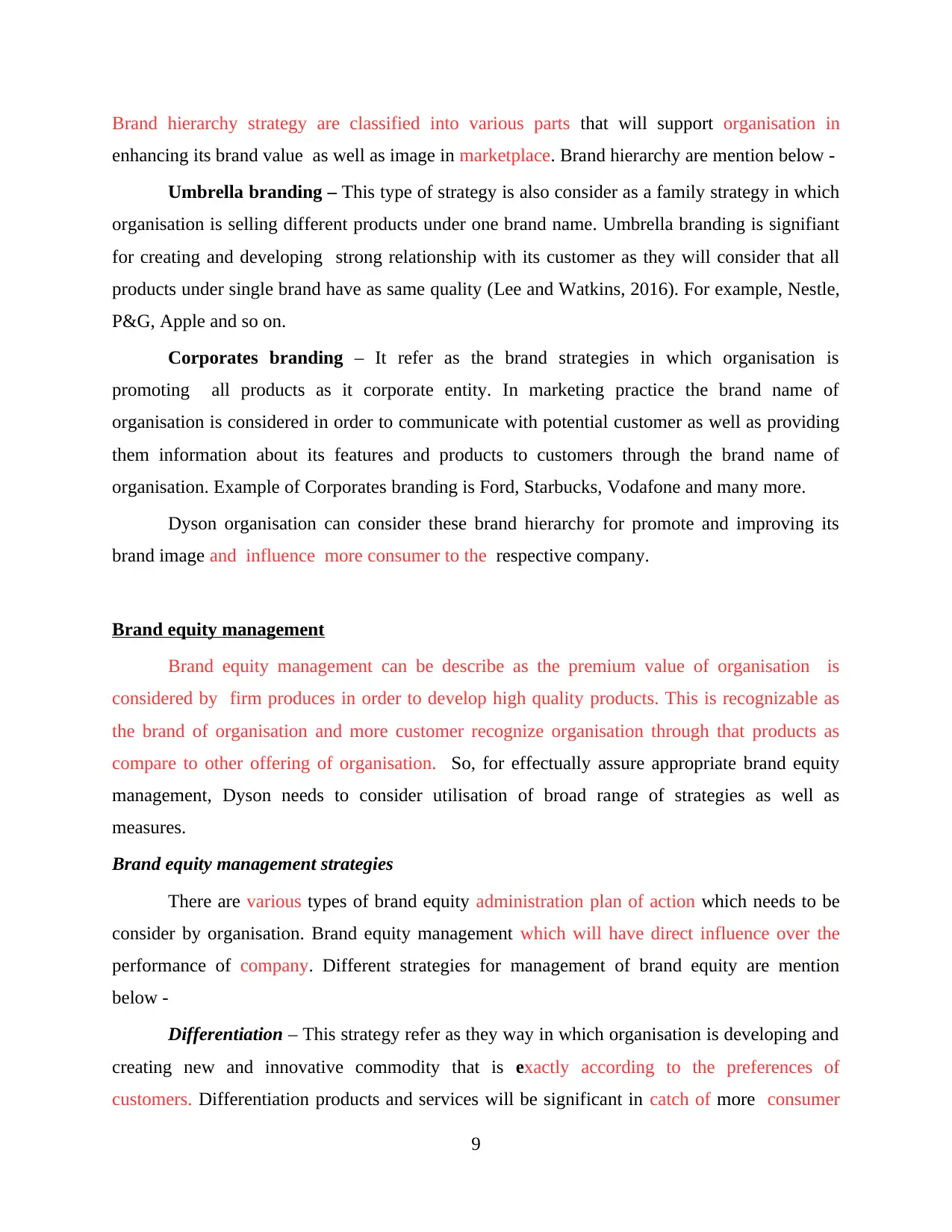
Brand hierarchy strategy are classified into various parts that will support organisation in
enhancing its brand value as well as image in marketplace. Brand hierarchy are mention below -
Umbrella branding – This type of strategy is also consider as a family strategy in which
organisation is selling different products under one brand name. Umbrella branding is signifiant
for creating and developing strong relationship with its customer as they will consider that all
products under single brand have as same quality (Lee and Watkins, 2016). For example, Nestle,
P&G, Apple and so on.
Corporates branding – It refer as the brand strategies in which organisation is
promoting all products as it corporate entity. In marketing practice the brand name of
organisation is considered in order to communicate with potential customer as well as providing
them information about its features and products to customers through the brand name of
organisation. Example of Corporates branding is Ford, Starbucks, Vodafone and many more.
Dyson organisation can consider these brand hierarchy for promote and improving its
brand image and influence more consumer to the respective company.
Brand equity management
Brand equity management can be describe as the premium value of organisation is
considered by firm produces in order to develop high quality products. This is recognizable as
the brand of organisation and more customer recognize organisation through that products as
compare to other offering of organisation. So, for effectually assure appropriate brand equity
management, Dyson needs to consider utilisation of broad range of strategies as well as
measures.
Brand equity management strategies
There are various types of brand equity administration plan of action which needs to be
consider by organisation. Brand equity management which will have direct influence over the
performance of company. Different strategies for management of brand equity are mention
below -
Differentiation – This strategy refer as they way in which organisation is developing and
creating new and innovative commodity that is exactly according to the preferences of
customers. Differentiation products and services will be significant in catch of more consumer
9
enhancing its brand value as well as image in marketplace. Brand hierarchy are mention below -
Umbrella branding – This type of strategy is also consider as a family strategy in which
organisation is selling different products under one brand name. Umbrella branding is signifiant
for creating and developing strong relationship with its customer as they will consider that all
products under single brand have as same quality (Lee and Watkins, 2016). For example, Nestle,
P&G, Apple and so on.
Corporates branding – It refer as the brand strategies in which organisation is
promoting all products as it corporate entity. In marketing practice the brand name of
organisation is considered in order to communicate with potential customer as well as providing
them information about its features and products to customers through the brand name of
organisation. Example of Corporates branding is Ford, Starbucks, Vodafone and many more.
Dyson organisation can consider these brand hierarchy for promote and improving its
brand image and influence more consumer to the respective company.
Brand equity management
Brand equity management can be describe as the premium value of organisation is
considered by firm produces in order to develop high quality products. This is recognizable as
the brand of organisation and more customer recognize organisation through that products as
compare to other offering of organisation. So, for effectually assure appropriate brand equity
management, Dyson needs to consider utilisation of broad range of strategies as well as
measures.
Brand equity management strategies
There are various types of brand equity administration plan of action which needs to be
consider by organisation. Brand equity management which will have direct influence over the
performance of company. Different strategies for management of brand equity are mention
below -
Differentiation – This strategy refer as they way in which organisation is developing and
creating new and innovative commodity that is exactly according to the preferences of
customers. Differentiation products and services will be significant in catch of more consumer
9
⊘ This is a preview!⊘
Do you want full access?
Subscribe today to unlock all pages.

Trusted by 1+ million students worldwide
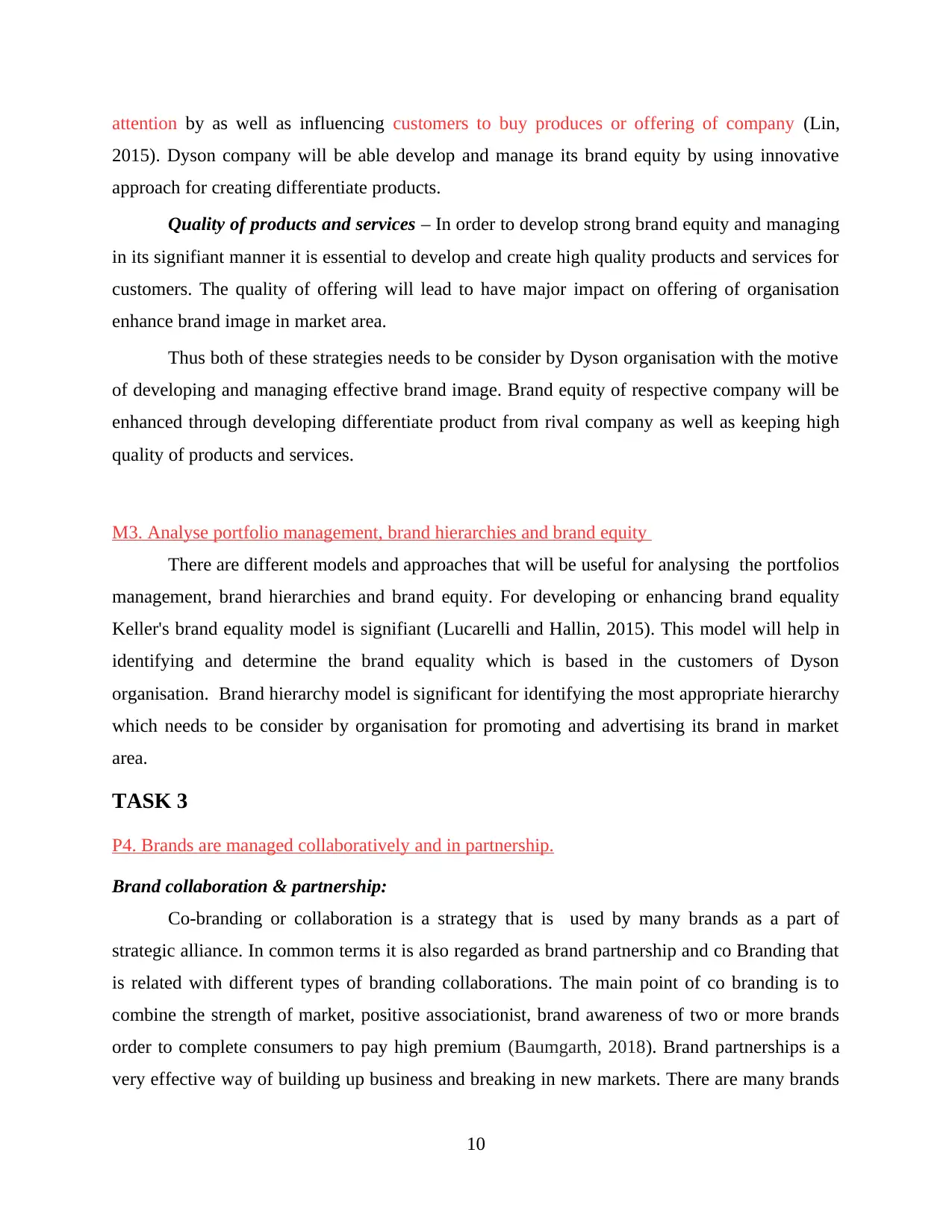
attention by as well as influencing customers to buy produces or offering of company (Lin,
2015). Dyson company will be able develop and manage its brand equity by using innovative
approach for creating differentiate products.
Quality of products and services – In order to develop strong brand equity and managing
in its signifiant manner it is essential to develop and create high quality products and services for
customers. The quality of offering will lead to have major impact on offering of organisation
enhance brand image in market area.
Thus both of these strategies needs to be consider by Dyson organisation with the motive
of developing and managing effective brand image. Brand equity of respective company will be
enhanced through developing differentiate product from rival company as well as keeping high
quality of products and services.
M3. Analyse portfolio management, brand hierarchies and brand equity
There are different models and approaches that will be useful for analysing the portfolios
management, brand hierarchies and brand equity. For developing or enhancing brand equality
Keller's brand equality model is signifiant (Lucarelli and Hallin, 2015). This model will help in
identifying and determine the brand equality which is based in the customers of Dyson
organisation. Brand hierarchy model is significant for identifying the most appropriate hierarchy
which needs to be consider by organisation for promoting and advertising its brand in market
area.
TASK 3
P4. Brands are managed collaboratively and in partnership.
Brand collaboration & partnership:
Co-branding or collaboration is a strategy that is used by many brands as a part of
strategic alliance. In common terms it is also regarded as brand partnership and co Branding that
is related with different types of branding collaborations. The main point of co branding is to
combine the strength of market, positive associationist, brand awareness of two or more brands
order to complete consumers to pay high premium (Baumgarth, 2018). Brand partnerships is a
very effective way of building up business and breaking in new markets. There are many brands
10
2015). Dyson company will be able develop and manage its brand equity by using innovative
approach for creating differentiate products.
Quality of products and services – In order to develop strong brand equity and managing
in its signifiant manner it is essential to develop and create high quality products and services for
customers. The quality of offering will lead to have major impact on offering of organisation
enhance brand image in market area.
Thus both of these strategies needs to be consider by Dyson organisation with the motive
of developing and managing effective brand image. Brand equity of respective company will be
enhanced through developing differentiate product from rival company as well as keeping high
quality of products and services.
M3. Analyse portfolio management, brand hierarchies and brand equity
There are different models and approaches that will be useful for analysing the portfolios
management, brand hierarchies and brand equity. For developing or enhancing brand equality
Keller's brand equality model is signifiant (Lucarelli and Hallin, 2015). This model will help in
identifying and determine the brand equality which is based in the customers of Dyson
organisation. Brand hierarchy model is significant for identifying the most appropriate hierarchy
which needs to be consider by organisation for promoting and advertising its brand in market
area.
TASK 3
P4. Brands are managed collaboratively and in partnership.
Brand collaboration & partnership:
Co-branding or collaboration is a strategy that is used by many brands as a part of
strategic alliance. In common terms it is also regarded as brand partnership and co Branding that
is related with different types of branding collaborations. The main point of co branding is to
combine the strength of market, positive associationist, brand awareness of two or more brands
order to complete consumers to pay high premium (Baumgarth, 2018). Brand partnerships is a
very effective way of building up business and breaking in new markets. There are many brands
10
Paraphrase This Document
Need a fresh take? Get an instant paraphrase of this document with our AI Paraphraser
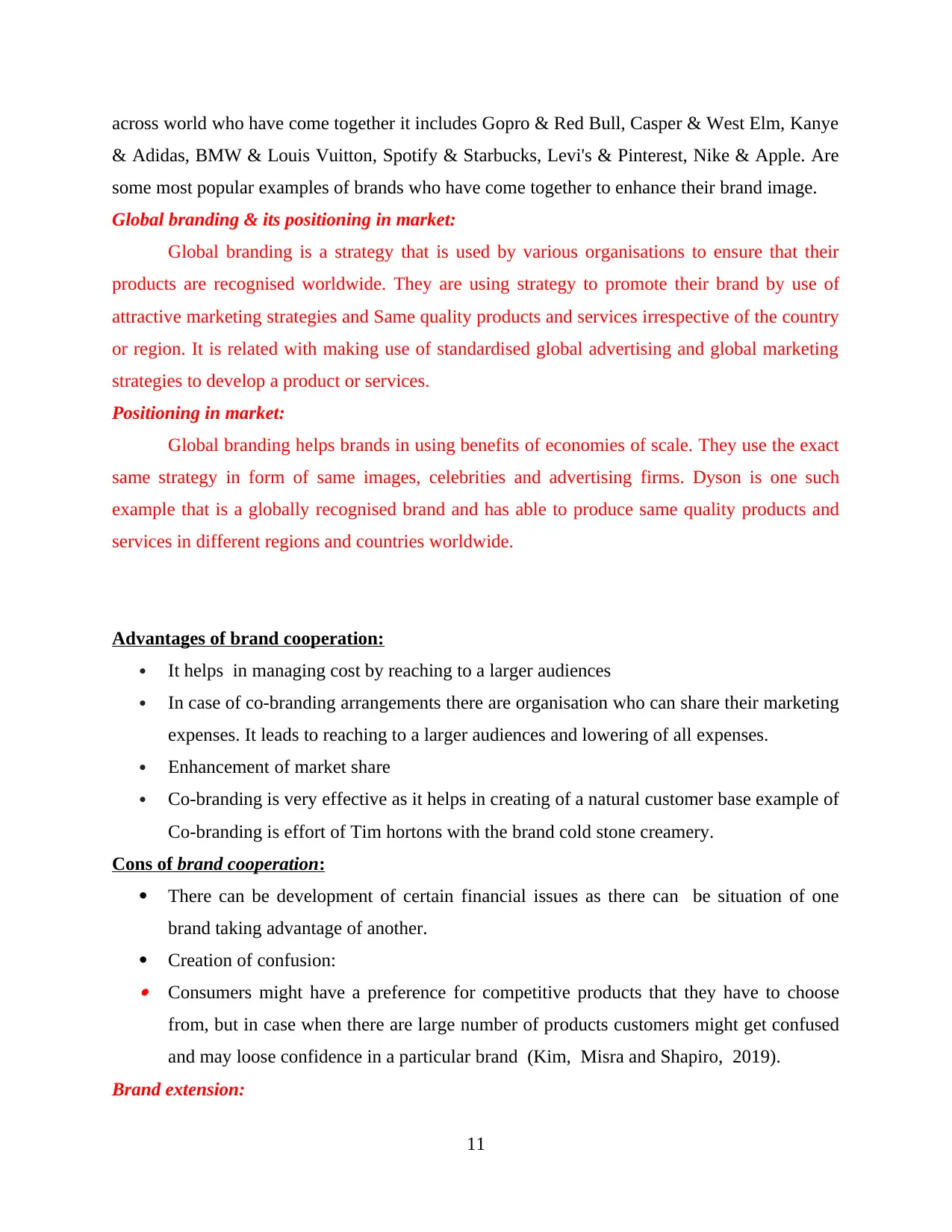
across world who have come together it includes Gopro & Red Bull, Casper & West Elm, Kanye
& Adidas, BMW & Louis Vuitton, Spotify & Starbucks, Levi's & Pinterest, Nike & Apple. Are
some most popular examples of brands who have come together to enhance their brand image.
Global branding & its positioning in market:
Global branding is a strategy that is used by various organisations to ensure that their
products are recognised worldwide. They are using strategy to promote their brand by use of
attractive marketing strategies and Same quality products and services irrespective of the country
or region. It is related with making use of standardised global advertising and global marketing
strategies to develop a product or services.
Positioning in market:
Global branding helps brands in using benefits of economies of scale. They use the exact
same strategy in form of same images, celebrities and advertising firms. Dyson is one such
example that is a globally recognised brand and has able to produce same quality products and
services in different regions and countries worldwide.
Advantages of brand cooperation:
It helps in managing cost by reaching to a larger audiences
In case of co-branding arrangements there are organisation who can share their marketing
expenses. It leads to reaching to a larger audiences and lowering of all expenses.
Enhancement of market share
Co-branding is very effective as it helps in creating of a natural customer base example of
Co-branding is effort of Tim hortons with the brand cold stone creamery.
Cons of brand cooperation:
There can be development of certain financial issues as there can be situation of one
brand taking advantage of another.
Creation of confusion: Consumers might have a preference for competitive products that they have to choose
from, but in case when there are large number of products customers might get confused
and may loose confidence in a particular brand (Kim, Misra and Shapiro, 2019).
Brand extension:
11
& Adidas, BMW & Louis Vuitton, Spotify & Starbucks, Levi's & Pinterest, Nike & Apple. Are
some most popular examples of brands who have come together to enhance their brand image.
Global branding & its positioning in market:
Global branding is a strategy that is used by various organisations to ensure that their
products are recognised worldwide. They are using strategy to promote their brand by use of
attractive marketing strategies and Same quality products and services irrespective of the country
or region. It is related with making use of standardised global advertising and global marketing
strategies to develop a product or services.
Positioning in market:
Global branding helps brands in using benefits of economies of scale. They use the exact
same strategy in form of same images, celebrities and advertising firms. Dyson is one such
example that is a globally recognised brand and has able to produce same quality products and
services in different regions and countries worldwide.
Advantages of brand cooperation:
It helps in managing cost by reaching to a larger audiences
In case of co-branding arrangements there are organisation who can share their marketing
expenses. It leads to reaching to a larger audiences and lowering of all expenses.
Enhancement of market share
Co-branding is very effective as it helps in creating of a natural customer base example of
Co-branding is effort of Tim hortons with the brand cold stone creamery.
Cons of brand cooperation:
There can be development of certain financial issues as there can be situation of one
brand taking advantage of another.
Creation of confusion: Consumers might have a preference for competitive products that they have to choose
from, but in case when there are large number of products customers might get confused
and may loose confidence in a particular brand (Kim, Misra and Shapiro, 2019).
Brand extension:
11
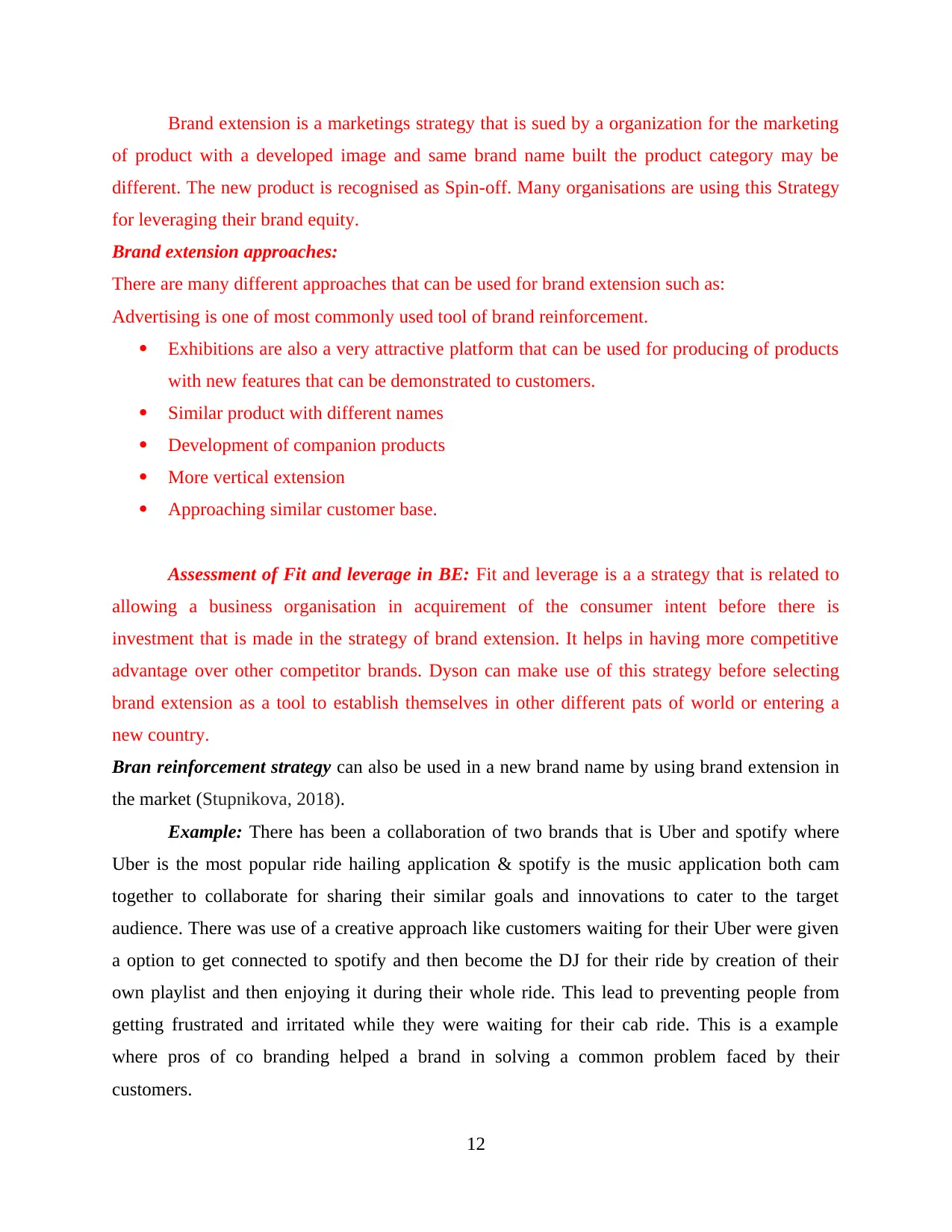
Brand extension is a marketings strategy that is sued by a organization for the marketing
of product with a developed image and same brand name built the product category may be
different. The new product is recognised as Spin-off. Many organisations are using this Strategy
for leveraging their brand equity.
Brand extension approaches:
There are many different approaches that can be used for brand extension such as:
Advertising is one of most commonly used tool of brand reinforcement.
Exhibitions are also a very attractive platform that can be used for producing of products
with new features that can be demonstrated to customers.
Similar product with different names
Development of companion products
More vertical extension
Approaching similar customer base.
Assessment of Fit and leverage in BE: Fit and leverage is a a strategy that is related to
allowing a business organisation in acquirement of the consumer intent before there is
investment that is made in the strategy of brand extension. It helps in having more competitive
advantage over other competitor brands. Dyson can make use of this strategy before selecting
brand extension as a tool to establish themselves in other different pats of world or entering a
new country.
Bran reinforcement strategy can also be used in a new brand name by using brand extension in
the market (Stupnikova, 2018).
Example: There has been a collaboration of two brands that is Uber and spotify where
Uber is the most popular ride hailing application & spotify is the music application both cam
together to collaborate for sharing their similar goals and innovations to cater to the target
audience. There was use of a creative approach like customers waiting for their Uber were given
a option to get connected to spotify and then become the DJ for their ride by creation of their
own playlist and then enjoying it during their whole ride. This lead to preventing people from
getting frustrated and irritated while they were waiting for their cab ride. This is a example
where pros of co branding helped a brand in solving a common problem faced by their
customers.
12
of product with a developed image and same brand name built the product category may be
different. The new product is recognised as Spin-off. Many organisations are using this Strategy
for leveraging their brand equity.
Brand extension approaches:
There are many different approaches that can be used for brand extension such as:
Advertising is one of most commonly used tool of brand reinforcement.
Exhibitions are also a very attractive platform that can be used for producing of products
with new features that can be demonstrated to customers.
Similar product with different names
Development of companion products
More vertical extension
Approaching similar customer base.
Assessment of Fit and leverage in BE: Fit and leverage is a a strategy that is related to
allowing a business organisation in acquirement of the consumer intent before there is
investment that is made in the strategy of brand extension. It helps in having more competitive
advantage over other competitor brands. Dyson can make use of this strategy before selecting
brand extension as a tool to establish themselves in other different pats of world or entering a
new country.
Bran reinforcement strategy can also be used in a new brand name by using brand extension in
the market (Stupnikova, 2018).
Example: There has been a collaboration of two brands that is Uber and spotify where
Uber is the most popular ride hailing application & spotify is the music application both cam
together to collaborate for sharing their similar goals and innovations to cater to the target
audience. There was use of a creative approach like customers waiting for their Uber were given
a option to get connected to spotify and then become the DJ for their ride by creation of their
own playlist and then enjoying it during their whole ride. This lead to preventing people from
getting frustrated and irritated while they were waiting for their cab ride. This is a example
where pros of co branding helped a brand in solving a common problem faced by their
customers.
12
⊘ This is a preview!⊘
Do you want full access?
Subscribe today to unlock all pages.

Trusted by 1+ million students worldwide
1 out of 17
Related Documents
Your All-in-One AI-Powered Toolkit for Academic Success.
+13062052269
info@desklib.com
Available 24*7 on WhatsApp / Email
![[object Object]](/_next/static/media/star-bottom.7253800d.svg)
Unlock your academic potential
Copyright © 2020–2025 A2Z Services. All Rights Reserved. Developed and managed by ZUCOL.



